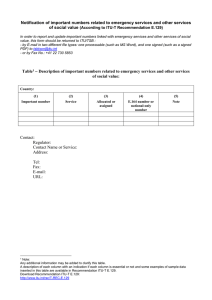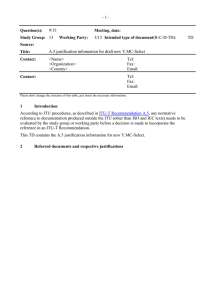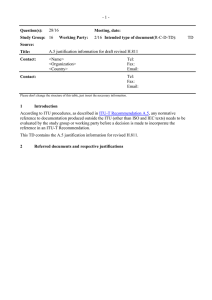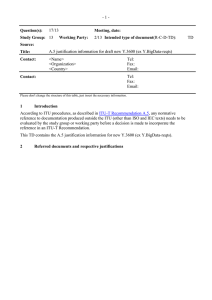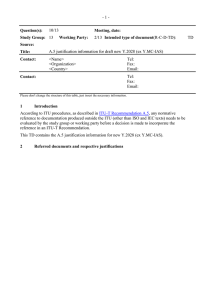I T U NTERNATIONAL
advertisement
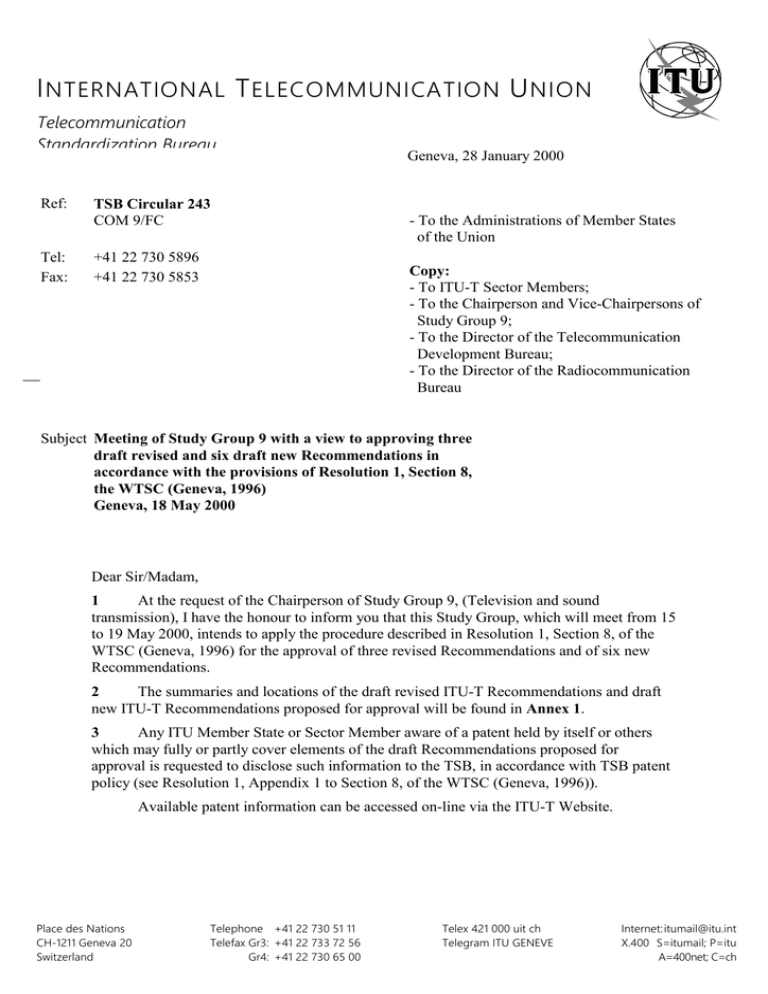
I NTERNATIONAL T ELECOMMUNICATION U NION Telecommunication Standardization Bureau Ref: Tel: Fax: TSB Circular 243 COM 9/FC +41 22 730 5896 +41 22 730 5853 Geneva, 28 January 2000 - To the Administrations of Member States of the Union Copy: - To ITU-T Sector Members; - To the Chairperson and Vice-Chairpersons of Study Group 9; - To the Director of the Telecommunication Development Bureau; - To the Director of the Radiocommunication Bureau Subject Meeting of Study Group 9 with a view to approving three draft revised and six draft new Recommendations in accordance with the provisions of Resolution 1, Section 8, of the WTSC (Geneva, 1996) Geneva, 18 May 2000 Dear Sir/Madam, 1 At the request of the Chairperson of Study Group 9, (Television and sound transmission), I have the honour to inform you that this Study Group, which will meet from 15 to 19 May 2000, intends to apply the procedure described in Resolution 1, Section 8, of the WTSC (Geneva, 1996) for the approval of three revised Recommendations and of six new Recommendations. 2 The summaries and locations of the draft revised ITU-T Recommendations and draft new ITU-T Recommendations proposed for approval will be found in Annex 1. 3 Any ITU Member State or Sector Member aware of a patent held by itself or others which may fully or partly cover elements of the draft Recommendations proposed for approval is requested to disclose such information to the TSB, in accordance with TSB patent policy (see Resolution 1, Appendix 1 to Section 8, of the WTSC (Geneva, 1996)). Available patent information can be accessed on-line via the ITU-T Website. Place des Nations CH-1211 Geneva 20 Switzerland Telephone +41 22 730 51 11 Telefax Gr3: +41 22 733 72 56 Gr4: +41 22 730 65 00 Telex 421 000 uit ch Telegram ITU GENEVE Internet: itumail@itu.int X.400 S=itumail; P=itu A=400net; C=ch -24 Having regard to the provisions of Resolution 1, Section 8, I should be grateful if you would inform me by 2400 hours UTC on 3 May 2000 (7 working days before the meeting) whether your Administration assigns authority to Study Group 9 that these draft revised or new Recommendations should be considered for approval at the Study Group meeting. Should any Member States be of the opinion that consideration for approval should not proceed, they should advise their reasons for disapproving and indicate the possible changes that would facilitate further consideration and approval of the draft revised or new Recommendations. 5 If 70% or more of the replies from Member States support consideration for approval of these draft revised or new Recommendations at the Study Group meeting, one Plenary session will be devoted on 18 May 2000 to apply the approval procedure. I accordingly invite your Administration to send a representative to the meeting. The Administrations of Member States of the Union are invited to supply the name of the Head of their delegation. If your Administration wishes to be represented at the meeting by a recognized operating agency, a scientific or industrial organization or another entity dealing with telecommunication matters, the Director should be duly informed, in accordance with Article 19, No. 239, of the Convention of the International Telecommunication Union (Geneva, 1992), as amended by the Plenipotentiary Conference (Minneapolis, 1998). 6 The agenda, registration form and all relevant information concerning the Study Group 9 meeting will be available from Collective-letter 7/9. 7 Information on the meeting room will be displayed on the screens at the entrances to the ITU headquarters building. 8 After the meeting, the Director of TSB will notify, in a circular, the decision taken on these Recommendations. This information will also be published in the ITU Operational Bulletin. Yours faithfully, H. Zhao Director of the Telecommunication Standardization Bureau Annex: 1 -3ANNEX 1 (to TSB Circular 243) Summaries and locations of ITU-T draft Recommendations for approval at the meeting of Study Group 9 (18 May 2000) 1 ITU-T draft revised Recommendation J.53 (text in COM 9-R 24) Sampling frequencies to be used for the digital transmission of studio-quality and highquality sound-programme signals Summary This Recommendation specifies the sampling frequency and tolerance to be used for the digital transmission of studio-quality and high-quality sound-programme signals. 2 ITU-T draft Amendment 1 to Recommendation J.87 (text in COM 9-R 24) Use of hybrid cable television links for the secondary distribution of television into the user’s premises Summary This amendment introduces a reference to OFDM (orthogonal frequency division multiplexing). 3 ITU-T draft revised Recommendation J.90 (text in COM 9-R 24) Electronic programme guides for delivery by digital cable television and similar methods – Reference operating scenario and requirements Summary This Recommendation specifies a reference operating scenario and a number of requirements applicable to Electronic Programme Guide (EPG) information delivered to the home by digital cable television and other similar distribution methods. Delivery of EPG information may be implemented through various operating scenarios; a typical scenario is described in Appendix I by way of an example and to serve as a reference. The importance of properly structured EPGs in which home viewers can readily navigate is becoming increasingly important with the current large increase in the number of programmes offered to the home, which is made possible by digital television delivery systems that employ bit rate reduction. This Recommendation is meant to catalyse the development of an efficient structure for EPG information, conducive to user-friendly interactive navigation tools that will help viewers to find their way among EPG information. -44 ITU-T draft new Recommendation J.116 (J.isl) (text in COM 9-R 23) Interaction channel for local multipoint distribution systems Summary This Recommendation is the baseline specification for the provision of an interaction channel for Local Multi-point Distribution Systems (LMDS) networks as a digital broadcasting delivery medium. 5 ITU-T draft new Recommendation J.118 (J.smatv/matv) (text in COM 9-R 24) Access systems for interactive services on SMATV/MATV networks Summary This Recommendation covers the definition of the framing structure, channel coding and modulation for the provision of an interaction channel throughout SMATV/MATV networks from the user to the SMATV/MATV head-end. The Recommendation defines two current technological alternatives for the interactive service provision in SMATV/MATV networks according to a bandwidth dependent classification. In particular, the cable based solution is suitable where broadband applications are concerned, while the Master Link Low Rate TDMA is suitable for narrow-band applications. 6 ITU-T draft new Recommendation J.120 (J.web) (text in COM 9-R 24) Distribution of sound and television programs over the IP network Summary This Recommendation defines the transmission protocol and system configuration for distributing sound and television programs over the IP network, commonly known as “Webcasting”. It specifies the operations necessary to adapt audio and video bitstreams to the Internet protocol and the functional characteristics associated with this system. 7 ITU-T draft new Recommendation J.142 (J.mdt) (text in COM 9-R 24) Methods for the measurement of parameters in the transmission of digital cable television signals Summary This Recommendation specifies objective methods for the measurement of parameters in the transmission of digital cable television signals. -58 ITU-T draft new Recommendation J.143 (J.ovq-req) (text in COM 9-R 24) User requirements for objective perceptual video quality measurements in digital cable television Summary This Recommendation describes user requirements for objective perceptual video quality measurements in digital cable television and similar applications. 9 ITU-T draft new Recommendation J.180 (J.mux) (text in COM 9-R 24 User requirements for statistical multiplexing of several programmes on a transmission channel Summary This Recommendation specifies the user requirements that should be considered for the statistical multiplexing of television and/or sound programmes as well as data programmes in order to improve the efficiency in case of utilizing a constant bit-rate digital transmission channel. It also provides a brief outline of statistical multiplexing techniques.
